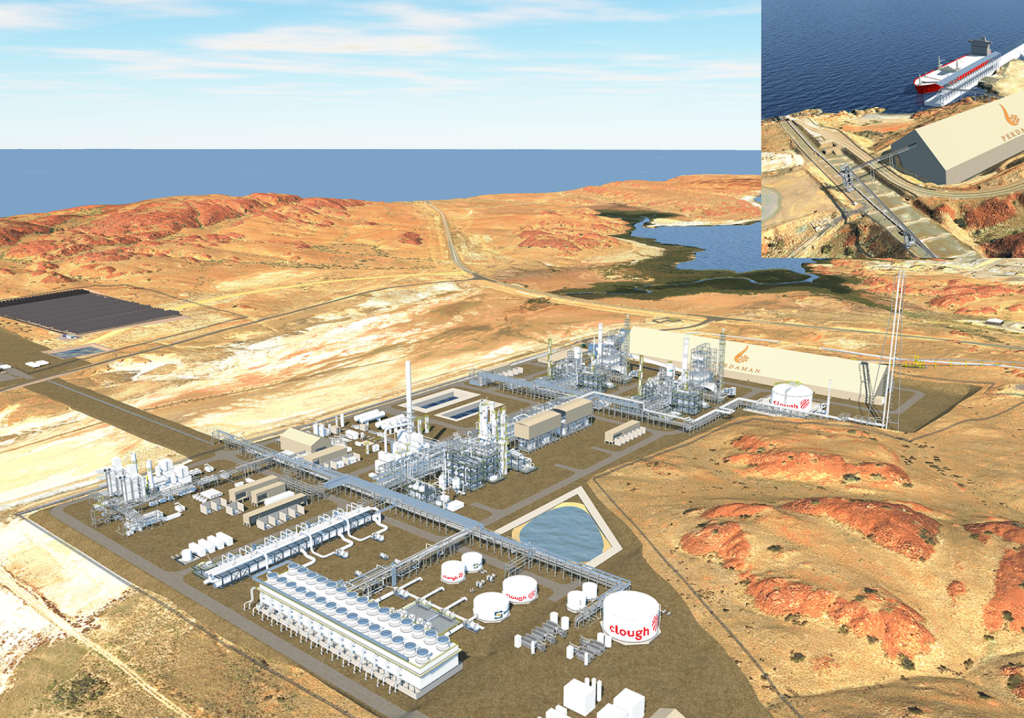The $6.4 billion urea plant in Western Australia will be the largest urea plant in Australia and one of the world’s largest single-train ammonia plants.
The global ammonia market, which reached around 167 million t in 2021, is expected to increase at a compound annual growth rate of 7.22 per cent from this year to 2030.
With the ammonia industry growing rapidly, numerous ammonia projects are taking off across the globe – including the Perdaman’s Project Ceres, a major Urea plant, in the Burrup Peninsula, approximately 10 km from Dampier and 20 km north-west of Karratha on the Western Australia coast.
Clough and Saipem, in a 50/50 joint venture, were chosen to develop Perdaman’s project. The scope of work includes engineering, procurement of equipment and materials, construction, pre-commissioning and commissioning for the execution of a latest-generation fertilisers plant with a capacity of 2.14 million t of urea per year. The facility will have a syngas production block, fertiliser production block, and offsite facilities and utilities.
Saipem is a global leader in the engineering and construction of major projects for the energy and infrastructure sectors, and in delivering urea and ammonia projects, operating in 50 countries with more than 30,000 employees. Saipem is the licence holder for SynCOR Ammonia technology from Topsoe.
Clough, a subsidiary of Webuild Group, is an engineering and construction company with extensive expertise in Australia’s energy, resources, and infrastructure industry. It has more than 3000 employees and more than 2000 projects completed worldwide.
The Ceres Urea plant will produce fertiliser from urea by transforming natural gas into ammonia and then into urea. The joint-venture will install the new avant-garde SynCOR Ammonia technology from Topsoe, making the largest ammonia plant in the world on a single synthesis reactor. At the same time, the production process of urea will use Snamprogetti proprietary technology. The plant will also have a control system to ensure that the urea produced will be of the highest quality.
“This is going to be one of the biggest single-train gas stream plants in the world,” Project Director John Guyer said. “I’m proud to be part of such a strategic project for Western Australia and our nation that will provide positive economic, financial, social and environmental outcomes. The project, which has been a huge collaborative effort with Perdaman, will support one of Australia’s most valuable natural resources: natural gas.
“When you look around at the opportunities to get involved in ammonia, there are a lot of small projects happening. This project presents a great opportunity to gain experience and be part of the next big thing.
“It’s one of the largest urea plants in Australia and one of the largest and cleanest. It’s up there as one of the mega-jobs happening right now anywhere in the country.”
Guyer says the project will require about a 2000-strong workforce at its peak during construction.
“There’s a huge opportunity to build a unique professional capability as part of this project,” Guyer said.
“Clough’s workforce is expected to double in the next year, and this is a once-in-a-lifetime opportunity to be part of the growth of Clough in Australia, and of construction and engineering in general.”
Strengthening the nation
Construction on the Ceres ammonia plant began in late 2023 and is expected to take around four years of continuous work until it’s operational. More recently, the project celebrated the first steel cut at Larsen & Toubro (L&T)’s Modular Fabrication Yard in Chennai, India.
International cooperation is required to bring this mega project to life, and this milestone is a testament to the efficient and effective hard work of this diverse group of companies.
Net zero from Western Australia to the world
With the project set to deliver huge benefits, engineers working on the plant have the opportunity to contribute to Australia’s future food security.
“This project will move Australia from being a net importer of fertiliser, mostly made of ammonia, to a net exporter,” Adam Charles, Engineering Manager for the project, explained. “That’s hugely significant.”
This is important security for Australia in a geopolitically fragile environment.
Saipem has a unique experience and track record in the construction of urea/ammonia complexes, along with Clough’s local engineering experience and capability to process and construct complex infrastructure in remote locations.
Engineers are also working to ensure environmental efficiency remains a key focal point.
“The plant has been designed to minimise both industrial emissions and the carbon footprint of fertiliser production with the capacity to achieve net carbon zero by 2050,” Charles said.
“For example, we are working to ensure that the causeway design and other tidal flows are impacted to the minimal extent possible.”
“The project is set to be a best-practice model for high-energy efficiency and degree of modularisation. Flue gas carbon dioxide emissions are minimised, and most carbon dioxide is directly captured in the pre-combustion process.
“Keeping emissions down is a major driver throughout the project. We are reusing carbon dioxide to convert urea into ammonia, and we are selecting efficient equipment that results in lower emissions than an unoptimised plant.”
To get involved in the project, view the range of career opportunities at Clough.

